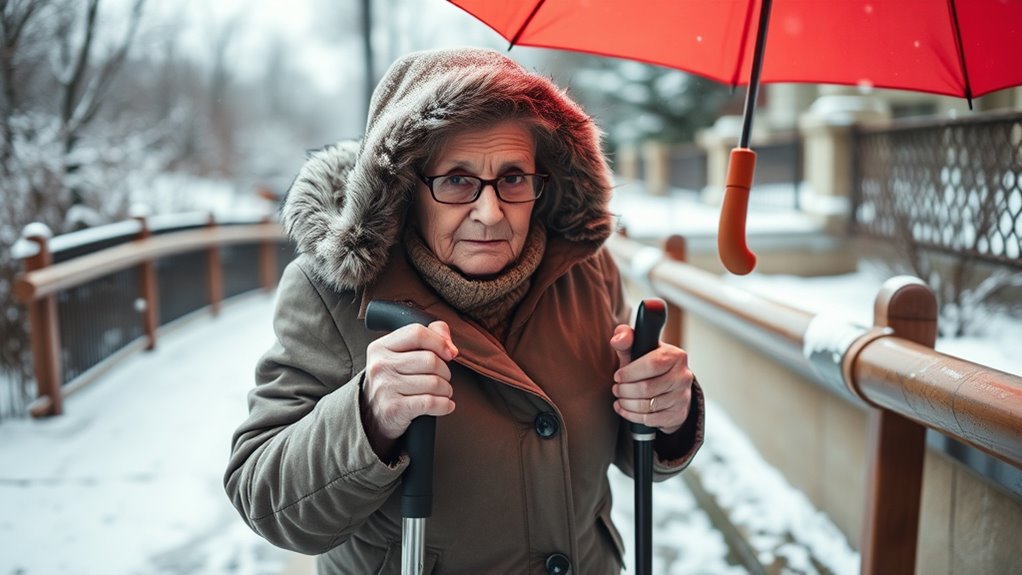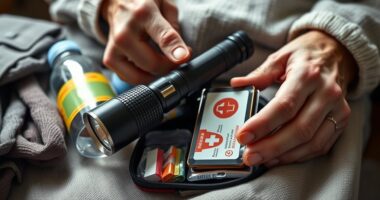To stay safe during extreme weather, prepare your home with proper insulation, storm shelters, and snow removal. Dress appropriately with layered clothing, hats, and gloves for cold, and use sunscreen and sunglasses in the heat. Stay hydrated by drinking fluids regularly, and recognize signs of dehydration, cold injury, or heat-related illnesses. Plan outdoor activities carefully, avoiding storms and extreme conditions. Keep emergency contacts handy and stay informed with weather updates to protect yourself effectively.
Key Takeaways
- Prepare your home with storm shelters, clear snow and ice, and reinforce doors and windows for cold weather safety.
- Dress in layered, insulated clothing, wear sun protection, and use appropriate footwear to prevent slips and sun damage outdoors.
- Stay hydrated by consuming fluids regularly, recognize signs of dehydration, and use health monitoring tools for early detection.
- Check weather forecasts before outdoor activities, wear suitable clothing, and avoid extreme conditions like storms or excessive heat.
- Keep emergency supplies, update contacts, and subscribe to weather alerts to ensure preparedness during weather-related emergencies.
Preparing Your Home for Extreme Temperatures
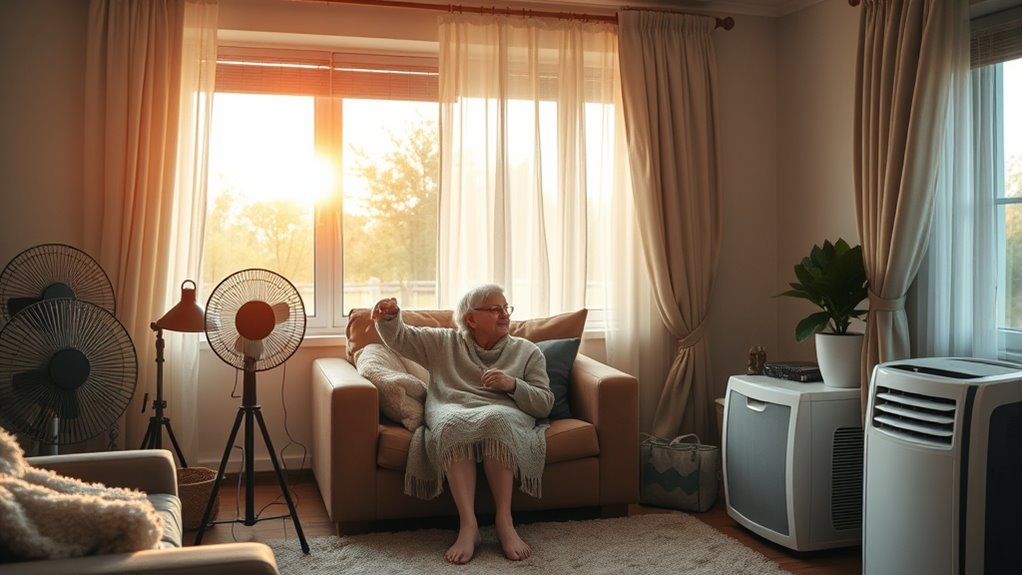
Preparing your home for extreme temperatures is essential to guarantee safety and comfort during heatwaves or cold snaps. To do this, consider installing storm shelters where you can seek refuge during severe weather events. Make sure your shelter is easily accessible and equipped with essentials. During winter, prioritize snow removal around your home to prevent ice buildup and maintain safe pathways. Clear driveways and walkways regularly to reduce fall risks. Check your insulation and seal any drafts to keep indoor temperatures stable. Installing storm windows and reinforcing doors can also help maintain warmth in cold seasons. Being proactive with storm shelters and snow removal keeps your home safer, ensuring you stay comfortable and protected regardless of the weather outside. Additionally, staying informed about weather patterns and automation in emergency response can help you respond swiftly to changing conditions. Properly maintaining and inspecting your fire prevention equipment like smoke alarms and extinguishers is also crucial for safety during extreme weather events.
Dressing Appropriately for the Weather
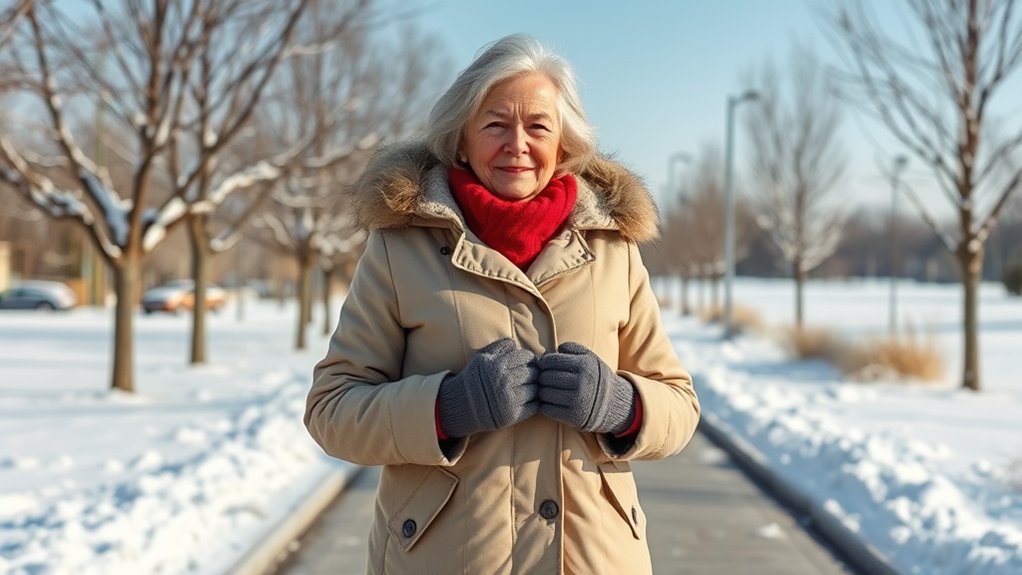
Dressing properly for the weather helps keep you safe and comfortable. On cold days, layering your clothes traps heat and protects you from the chill. Don’t forget to wear sunscreen and sunglasses when it’s sunny to shield your skin and eyes. Additionally, wearing appropriate protective gear, such as reflective clothing or a helmet when cycling, can enhance your safety during outdoor activities. Using clothing with glycolic acid can also help in maintaining healthy, smooth skin exposed to varying weather conditions.
Layer Up for Cold Days
When the temperature drops, layering your clothing is essential to stay warm and safe. Using effective layering strategies helps trap body heat and prevents cold-related health issues. Start with a moisture-wicking base layer, like thermal clothing, to keep sweat away from your skin. Add an insulating layer, such as a fleece or sweater, for warmth. Finish with a waterproof, wind-resistant outer layer to block harsh elements. For headphones, selecting the appropriate headphone jack type ensures compatibility with your devices in cold weather, especially when using outdoor audio gear. Proper layering boosts comfort and safety during cold days, helping you stay warm and avoid hypothermia. Additionally, being aware of support hours at local entertainment venues can help you plan indoor activities if the weather conditions worsen. Remember also to wear appropriate footwear to prevent slips and falls on icy surfaces. Incorporating clothing with color temperature adjustments can further optimize your comfort by adjusting to changing light and temperature conditions outdoors.
Wear Sun Protection
Since the sun can be strong even on cooler days, wearing sun protection is essential to keep your skin safe. UV protection helps prevent skin damage and reduces the risk of skin cancer. Always wear a wide-brimmed hat to shield your face, neck, and ears from direct sunlight. Pair it with sunglasses that block 100% of UV rays to protect your eyes from harmful UV exposure. When outdoors, apply a broad-spectrum sunscreen with at least SPF 30 to exposed skin, especially on your face, arms, and hands. Reapply every two hours or after sweating or swimming. Wearing the right clothing and accessories can make a big difference in preventing sunburn and long-term skin issues, keeping you safe during sunny days. Proper sun safety practices are key to protecting your skin and overall health. Incorporating skin protection strategies from reliable sources can further enhance your safety and reduce health risks. Additionally, understanding weather-related risks can help you better prepare for changing conditions and stay safe year-round. Being aware of candle melting conditions can also prevent outdoor hazards caused by unexpectedly warm weather.
Staying Hydrated During Hot Weather
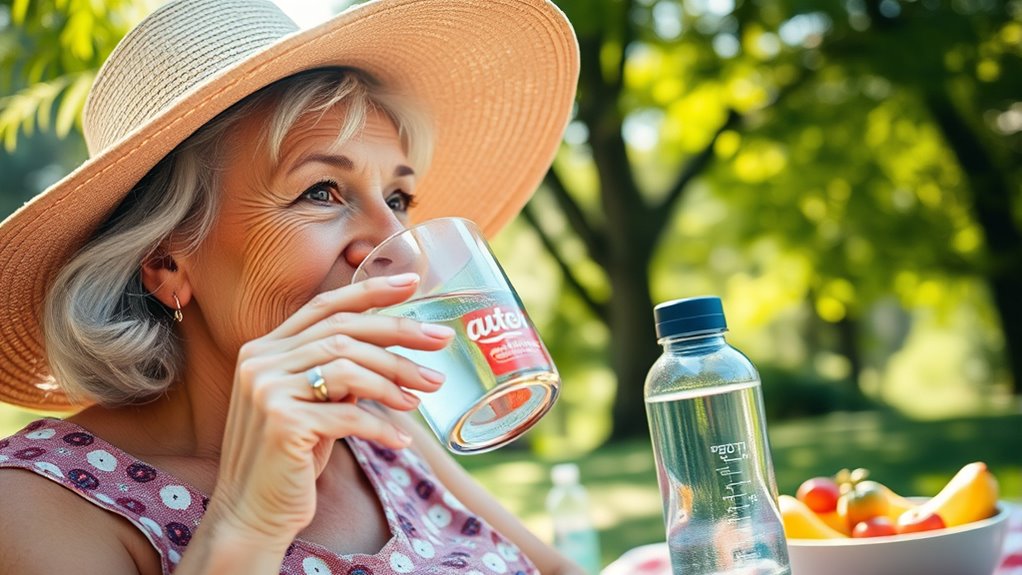
To stay properly hydrated in hot weather, consider drinking electrolyte-rich beverages to replace lost minerals and fluids. It’s also helpful to schedule regular fluid intake throughout the day, so you don’t forget to drink. This way, you can better maintain your hydration and avoid dehydration. Additionally, being aware of lifevest advisors can help you recognize signs of dehydration and take timely action to stay safe. Paying attention to AI safety measures can also be useful in understanding how to protect yourself from potential health risks related to heat exposure. Incorporating hydration strategies such as consuming water-rich fruits and vegetables can further support your hydration efforts, especially since glycolic acid products can sometimes cause skin sensitivity if not used properly. Being mindful of protective styling benefits can help prevent excessive sweating and skin irritation during hot weather.
Electrolyte-Rich Beverages
During hot weather, staying properly hydrated is essential, especially for elderly adults who are more vulnerable to dehydration. Electrolyte-rich beverages help maintain electrolyte balance, which is vital for muscle function and nerve health. Drinking water alone might not replenish lost minerals after sweating, so consider hydration supplements or drinks with added electrolytes. These beverages restore sodium, potassium, and magnesium levels, reducing the risk of dizziness, cramps, and fatigue. When choosing electrolyte-rich drinks, look for low sugar options that suit your health needs. Incorporating these drinks into your routine can also promote healthier relationship patterns, as maintaining proper hydration supports overall well-being. Proper hydration with electrolyte balance also plays a role in preventing heat-related illnesses, especially during heatwaves or outdoor activities. Additionally, understanding how music therapy can aid in emotional well-being may encourage a holistic approach to health during challenging conditions. Incorporate them into your daily routine, especially during heatwaves or outdoor activities. Proper hydration with electrolyte balance supports overall health and helps prevent heat-related illnesses in elderly adults. A good understanding of inspirational quotes about fatherhood can also serve as a reminder of the importance of nurturing and caring for loved ones during challenging conditions.
Schedule Fluid Intake
How can you guarantee you stay properly hydrated in hot weather? The key is to schedule fluid intake throughout the day. Set hydration reminders on your phone or use a timer to prompt you to drink regularly. Keep a water bottle nearby to encourage consistent fluid monitoring. Don’t wait until you’re thirsty, as thirst can be a late sign of dehydration. Instead, sip fluids at regular intervals, especially during outdoor activities or when feeling overheated. Remember, older adults may need more frequent reminders to maintain proper hydration levels. Staying ahead with your fluid intake helps prevent dehydration and heat-related illnesses. Security systems can also provide peace of mind by alerting you to unusual activity during hot weather when you may be less attentive. Prioritize your health by making hydration a routine part of your day, even when you don’t feel thirsty. Recognizing soulmate angel numbers can also serve as a spiritual reminder to nurture your emotional well-being during stressful weather conditions. Additionally, maintaining proper hydration is crucial for overall lifestyle health and well-being. Incorporating knowledge about best grocery savings strategies can help you manage your nutrition and hydration budgets effectively during hot weather.
Protecting Against Cold and Frostbite
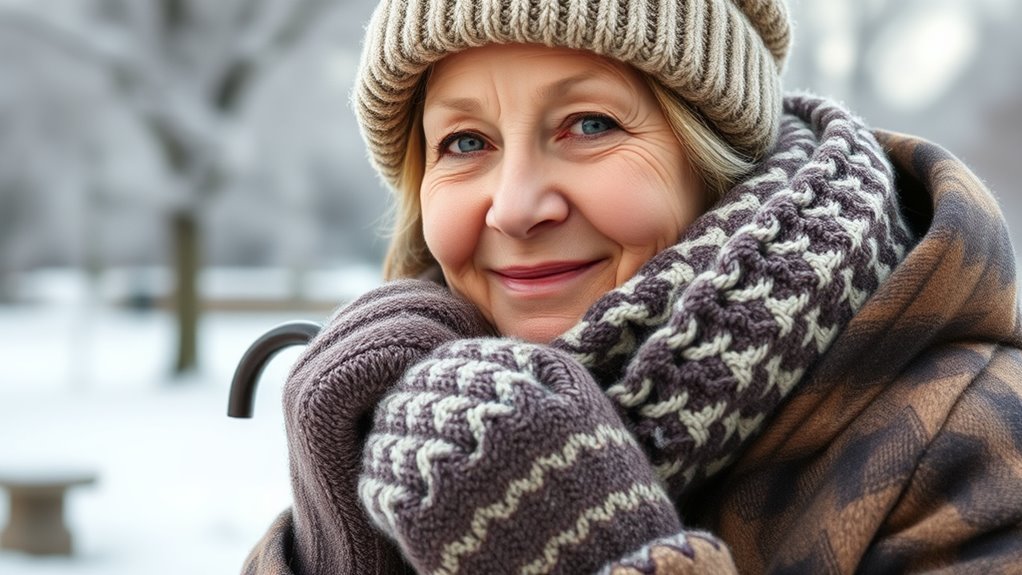
Cold weather can quickly lead to frostbite and hypothermia if you’re not careful. To protect yourself, focus on insulation tips and frostbite prevention strategies. Wear layered clothing, including thermal undergarments, to trap heat. Cover exposed skin with hats, scarves, and gloves to prevent frostbite. Stay dry, as moisture increases heat loss, and avoid prolonged exposure to cold environments. Keep your living space warm and use heating devices safely. Remember to regularly check your extremities—fingers, toes, nose, and ears—for signs of frostbite.
To enhance protection, consider these tips:
- Dress in insulated, weather-appropriate clothing
- Limit time outdoors during extreme cold
- Keep active to generate body heat
- Use hand and foot warmers when needed
- Maintain a warm, draft-free indoor environment
Recognizing and Responding to Weather-Related Health Symptoms

Being able to identify the signs of weather-related health issues is key to staying safe during cold and harsh conditions. Common symptoms include fatigue, mood changes, and difficulty breathing, which may signal seasonal affective disorder or poor indoor air quality. Recognizing these signs early helps you seek prompt care. Use this table to understand symptoms and responses:
| Symptom | Response |
|---|---|
| Fatigue, low energy | Increase indoor ventilation, seek sunlight |
| Mood swings, depression | Engage in light therapy or indoor activities |
| Shortness of breath | Consult your healthcare provider |
| Headaches or dizziness | Improve indoor air quality, stay hydrated |
| Feeling cold or shivering | Layer clothing, ensure proper heating |
Staying alert to these symptoms ensures you respond quickly and maintain your health during adverse weather.
Planning Safe Outdoor Activities
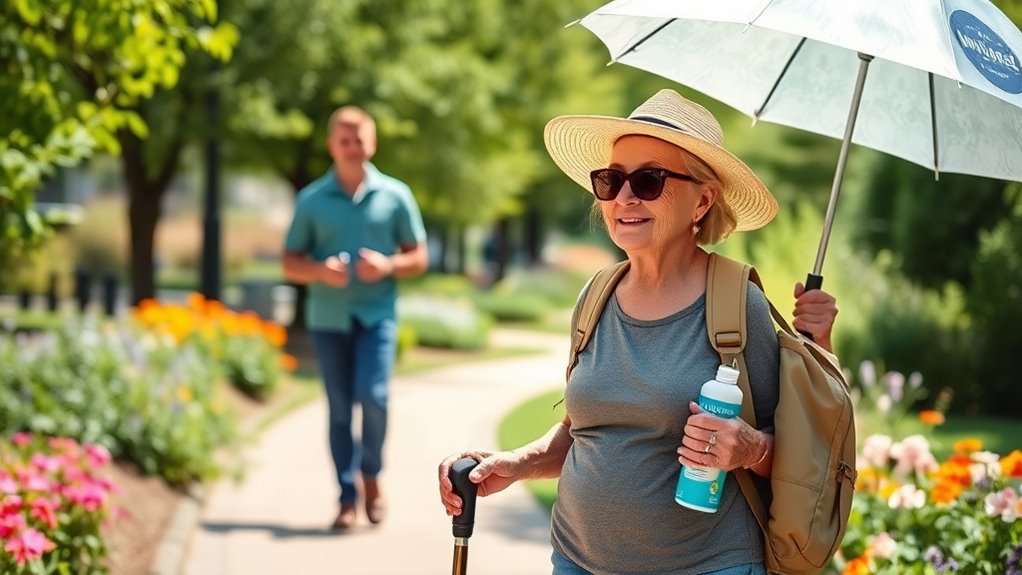
Planning safe outdoor activities during adverse weather requires careful preparation and awareness of your environment. When engaging in seasonal gardening or outdoor exercise, consider weather conditions and your physical limits. Always check the forecast before heading outside, and avoid outdoor activities during extreme heat, cold, or storms. To stay safe, keep these tips in mind:
- Wear appropriate clothing for the weather
- Choose shaded or breezy spots for outdoor exercise safety
- Limit activity duration to prevent fatigue or overheating
- Use sunscreen and hats during sunny days
- Stay hydrated, especially during physical activity
Being mindful of these precautions helps you enjoy outdoor activities while reducing risks. Proper planning ensures you stay comfortable and safe, whether tending your garden or walking outside.
Emergency Preparedness and Contact Information

When severe weather strikes, having an emergency plan and clear contact information can make all the difference in ensuring your safety. Make sure your emergency contacts are up-to-date and easily accessible, including family members, neighbors, and your healthcare providers. Keep a list of these contacts in your wallet and on your phone. If you use a medical alert system, confirm it’s functioning properly and that emergency responders can access your medical information quickly. Share your plan with trusted friends or family members so they know how to assist you if needed. Prepare a small emergency kit with essentials like water, medications, and important documents. Being proactive with your emergency contacts and medical alert systems guarantees you’re prepared for any severe weather situation.
Staying Informed With Weather Updates

How can you stay ahead of severe weather? Staying informed is key to your safety. By leveraging weather forecast tools, you can receive timely updates and plan accordingly. Enhancing your climate change awareness helps you understand the increasing unpredictability of weather patterns. To stay current, consider these strategies:
- Subscribe to local weather alerts via apps or text messages
- Check reputable weather websites regularly
- Use a weather radio for real-time updates
- Follow trusted weather experts on social media
- Keep your phone charged and ready for emergency alerts
Frequently Asked Questions
How Can I Prevent Falls During Icy Winter Conditions?
To prevent falls during icy winter conditions, you should be cautious on slippery sidewalks by walking slowly and taking small steps. Wear winter footwear with good traction to improve stability. Keep your walkways clear of snow and ice, and use handrails when available. Additionally, consider using a walking aid if needed, and stay indoors during severe weather. These precautions help reduce your risk of slipping and falling.
What Are the Signs of Heat Exhaustion or Heat Stroke?
You should watch for signs of heat exhaustion or heat stroke, like heavy sweating, weakness, dizziness, or nausea. Dehydration symptoms, such as dry mouth and dark urine, often accompany these conditions. To prevent heat stroke, stay hydrated, wear lightweight clothing, and avoid strenuous activities during the hottest parts of the day. Recognizing these signs early helps you act quickly and seek medical help if needed.
How Can I Reduce Indoor Air Pollution in Extreme Weather?
To improve indoor air quality during extreme weather, you should actively reduce pollution indoors. Keep your home well-ventilated by opening windows when outdoor air is safe, and use exhaust fans in kitchens and bathrooms. Avoid smoking indoors and limit the use of products that emit VOCs, like certain cleaning supplies and aerosols. Regularly change air filters and consider using air purifiers to enhance pollution reduction and maintain a healthier indoor environment.
Are There Specific Medications Affected by Temperature Changes?
You should be aware that temperature fluctuations can affect medication sensitivity, especially for elderly adults. Some medications may become less effective or cause side effects when exposed to extreme heat or cold. Always follow your healthcare provider’s advice, store medications properly, and monitor how you feel during temperature changes. If you notice any unusual reactions, contact your doctor promptly to adjust dosages or explore alternative treatments.
How Do I Help a Neighbor During Severe Weather Events?
During severe weather events, you can help your neighbor by conducting neighborhood check-ins to see if they need assistance. Make sure they have emergency preparedness supplies and know how to reach emergency services. Offer to help with tasks like securing their home or getting to a safe location. Your support can make a big difference, ensuring they stay safe and comfortable throughout the storm.
Conclusion
So, next time you happily ignore the weather forecast, remember—your cozy home and proper precautions can save you from surprises. Ironically, staying prepared might just be the coolest way to beat the heat or chill out safely. Don’t wait for a weather emergency to realize that a little vigilance today keeps the doctor—and headaches—away tomorrow. After all, who knew that listening to the weather could be the best way to stay ahead of Mother Nature’s mood swings?
